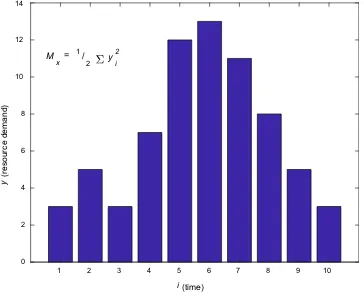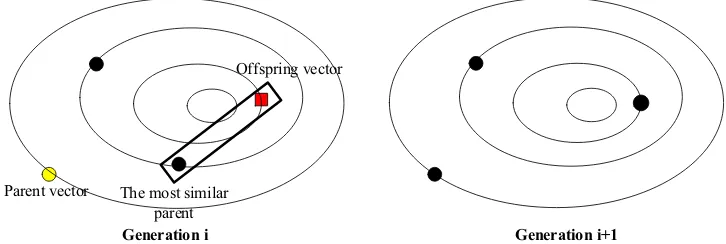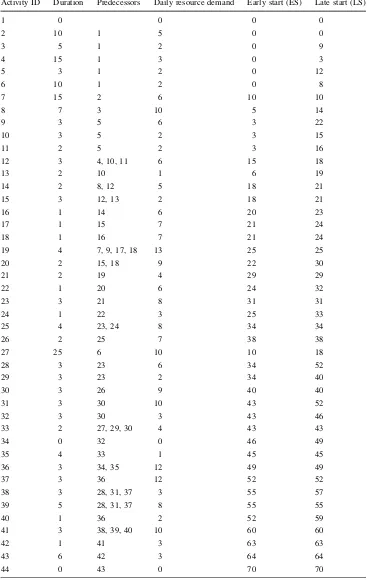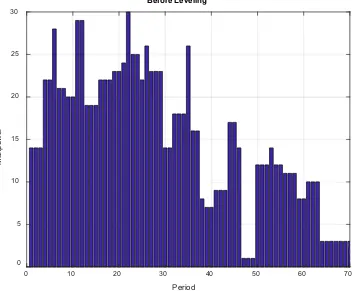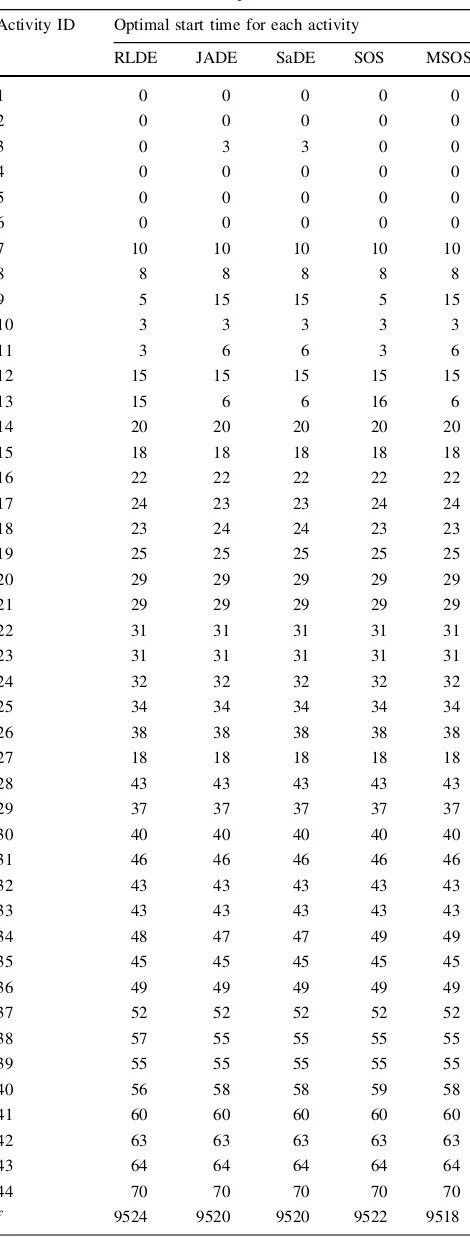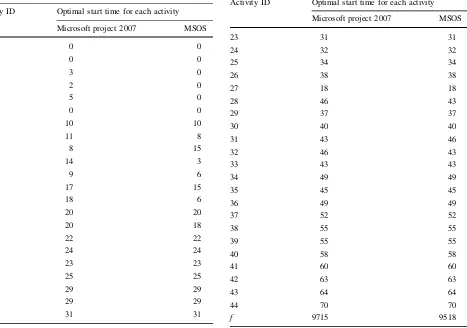ORIGINAL PAPER
Optimization model for construction project resource leveling using
a novel modified symbiotic organisms search
Doddy Prayogo1 •Min-Yuan Cheng2•Foek Tjong Wong1•Daniel Tjandra1•Duc-Hoc Tran3
Received: 10 January 2018 / Accepted: 19 April 2018
Springer International Publishing AG, part of Springer Nature 2018
Abstract
In the construction industry, determining project schedules has become one of the most critical subjects among project managers. These schedules oftentimes result in significant resource fluctuations that are costly and impractical for the construction company. Thus, construction managers are required to adjust the resource profile through a resource leveling process. In this paper, a novel optimization model is presented for resource leveling, called the ‘‘modified symbiotic organisms search’’ (MSOS). MSOS is developed based on the standard symbiotic organisms search, but with an improvement in the parasitism phase to better tackle complex optimization problems. A case study is employed to investigate the performance of the proposed optimization model in coping with the resource leveling problem. The experimental results show that the proposed model can find a better quality solution in comparison with existing opti-mization models.
Keywords Construction management Resource levelingOptimization MetaheuristicSymbiotic organisms search
Introduction
The capability of a construction company to handle resources is essential in order to survive and thrive in today’s market (Karaa and Nasr1986; Wu and An2012).
Any resource mismanagement could lead to a rise in operational expenses as well as scheduling and financial issues. If extra resources are needed on a construction site, then it could delay the projected completion of the project. When there is such a delay, the owner could sustain a financial loss because the facility is not yet available (Georgy2008). Furthermore, delays also lead to disagree-ments between parties, increases in overhead costs, loss in reputation, and, ultimately, total project failure (Arditi and Pattanakitchamroon 2006; Assaf and Al-Hejji2006). This is why implementing proper resource management in the planning stage of the project is an important task.
Generally, construction resources comprise equipment, materials, manpower, experience, and money. The key to a successful project is effective management of each resource (Georgy 2008). Nonetheless, construction sched-ules, as the result of network scheduling methods, tend to lead to inefficient, impractical, and expensive resource fluctuations (El-Rayes and Jun 2009). Therefore, con-struction managers must routinely perform some adjust-ments to the schedule to decrease the possibility of interrupting fluctuations during the project.
Construction companies are often bothered by these resource fluctuations due to the associated costs of hiring
& Doddy Prayogo
Min-Yuan Cheng [email protected]
Foek Tjong Wong [email protected]
Daniel Tjandra [email protected]
Duc-Hoc Tran [email protected]
1 Department of Civil Engineering, Petra Christian University,
Jalan Siwalankerto 121-131, Surabaya 60236, Indonesia
2 Department of Civil and Construction Engineering, National
Taiwan University of Science and Technology, #43, Sec. 4, Keelung Rd., Taipei 106, Taiwan, ROC
3 Department of Construction Engineering and Management,
Ho Chi Minh City University of Technology, 268 Ly Thuong Kiet St., Dist. 10, Ho Chi Minh City, Vietnam
and laying-off workers, even if it is for a short time (Martinez and Loannou 1993). If resources are not effi-ciently managed, they may result in the project being incomplete on the specified deadline. Moreover, construc-tion companies need to maintain idle resources even when demand is low. These facts could lead to a profit loss for a construction company.
Resource leveling is a method used to smooth resource fluctuations during a project and one that has received increasing attention by many researchers (Christodoulou et al.2009; El-Rayes and Jun2009). The goal of resource leveling is to reduce peak demand and fluctuations in the resource usage pattern. The method looks to reduce vari-ation in the resource profile by altering the non-important activities in their respective places and, thereby, main-taining the project’s schedule. There are several methods available such as mathematical, heuristics, and meta-heuristics that can solve a resource leveling problem for a construction project.
In the beginning, resource leveling problems were addressed with mathematical methods as they offered the best solutions to a problem. Over time, these techniques were no longer practical, especially for larger projects as resource leveling became a type of combinatorial problem as the increasing number of variables resulted in an infeasible problem-solving method. Therefore, mathemat-ical techniques are no longer ideal for real-life projects. Several studies have used heuristic methods to address the resource leveling issue (Harris 1990). Although resource leveling heuristics are simple and can be used widely with commercial project management software (e.g., Microsoft project), project managers are often left unsatisfied. This is because heuristic methods work on the premise of pre-designated rules and their performance is dependent upon a certain kind of problem and the implemented rules. There is no guarantee for the best solution (Hegazy1999).
With the limitations of both the heuristic and mathe-matics methods, researchers have shown an increased interest in adopting metaheuristic methods for solving resource leveling problems (Geng et al. 2011; Leu et al. 2000; Kaveh et al. 2016). Metaheuristic algorithms, inspired by natural phenomena, have been implemented successfully in various construction project problems to address optimization issues (Cheng et al. 2015; Kaveh 2017). These methods use iterative calculations to preserve the randomly initiated population to the best solution. Although metaheuristic algorithms, such as genetic algo-rithm (GA) (Goldberg1989), particle swarm optimization (PSO) (Kennedy and Eberhart 1995), and differential evolution (DE) (Storn and Price1997), play an integral part in the optimization field, they still have their drawbacks. For instance, the biggest challenges for metaheuristic algorithms is the poor exploitation and premature
convergence to deal with intricate optimization issues (Geng et al. 2011). Some researchers have boosted the performance of algorithms by using a hybrid approach (Cheng, et al.2016b; Cheng and Prayogo2017; Kaveh and Nasrollahi2013; Kaveh and Ilchi Ghazaan2018; Prayogo et al.2018).
Symbiotic organisms search (SOS), which is a popula-tion-based searching algorithm, has garnered interest over the past few years across the science and engineering fields (Cheng and Prayogo 2014). SOS is deemed both efficient and effective for continuous global optimization, using three symbiosis-inspired operators to ensure the population had the best global solution. SOS has been used success-fully many times over, surpassing other algorithms (Tran et al.2016; Cheng et al.2014; Prayogo et al. 2017). This paper presents a new modification of the standard SOS to achieve an acceptable solution to the resource leveling problems in construction projects, the so-called ‘‘modified symbiotic organisms search’’ (MSOS). In MSOS, a new and effective parasitism mechanism is employed to gen-erate a better searching ability by integrating the neigh-borhood search mechanism to the previous parasitism formula. For validating the performance of MSOS, an actual case study of a construction resource leveling problem is adopted.
The rest of the article is organized as follows: ‘‘Litera-ture review’’ reviews litera‘‘Litera-ture related to the establishment of the new optimization model; in ‘‘Proposed modified symbiotic organisms search (MSOS) algorithm’’ and ‘‘Practical implementation of MSOS for resource level-ing’’, the overall scenario of the newly proposed opti-mization model is presented in detail; ‘‘Experimental results’’ demonstrates a numerical experiment and results comparison for the proposed model; finally, ‘‘Conclusions’’ presents the conclusions and a discussion.
Literature review
Formulation of objective function for resource
leveling problem
f ¼X
T
i¼1
ðyi yuÞ 2
; ð1Þ
whereTis the project duration, yi represents the resource
requirements of all activities carried out at time uniti, and
yuis a uniform resource level provided by:
yu¼ PT
i¼1yi
T : ð2Þ
Son and Skibniewski (1999) further proposed a new formulation of the objective function as follows:
f ¼X
T
i¼1
y2i 2yuX
T
i¼1
yiþy2u; ð3Þ
where yu and PTi¼1yi are constant because the rates of resource and activity duration for each activity are fixed. Accordingly, the following equation expresses the objec-tive function:
f ¼X
T
i¼1
y2i: ð4Þ
Generally, as shown in Fig.1and drawing upon relevant literature (Hegazy 1999), Eq. (4) equals the minimum moment of the resource histogram around the time axis. Additionally, it is necessary to modify the objective func-tion of the resource leveling problem as the optimizafunc-tion
process can produce different scheduling solutions. Fur-thermore, the objective function values might be identical but the resource fluctuations might differ. Therefore, it is needed to take into consideration the deviations between the peak of resource demand and resource consumption in consecutive time periods (Easa 1989) to determine the most optimal resource profile. This research will later introduce a modified objective function for the resource leveling optimization model.
Metaheuristic applications on resource leveling
problem
When it comes to construction management, the problems with resource scheduling are looked at intensely because of their importance. Resource leveling, within resource scheduling, is one of the biggest problems because it is so complex (Hegazy 1999). Mathematical models have been used to try solving the problems (Easa1989) but are unable to address complex, large-scale problems that people encounter in real life. Heuristic rules were later applied to address the convoluted nature of resource levels (Martinez and Loannou1993). However, it appeared that this method only worked to solve certain problems. Heuristic rules do not always guarantee a solution, which is a real problem for some practitioners. Therefore, these facts motivate researchers to find other modern techniques, e.g.,
M x =
1
/
2 yi 2
1 2 3 4 5 6 7 8 9 10
i (time) 0
2 4 6 8 10 12 14
y (resource demand)
Fig. 1 Moment of resource
metaheuristic algorithms, to search for solutions to partic-ular problems (Geng et al.2011; Leu et al.2000).
Many studies have been proposed in the past decades to investigate the performance of metaheuristic optimization algorithms in solving different resource leveling problems in construction projects. In an early attempt, Hegazy (1999) proposed a GA to solve a resource leveling model based on minimum moment of resource histogram. Son and Skib-niewski (1999) developed a simulated annealing (SA) hybrid model for finding the best solution of the given resource leveling problems. To minimize the total of absolute deviations between each and average resource usage, Leu et al. (2000) employed a GA and further introduces a prototype of decision support system for resource leveling in addition to the optimization model. Khanzadi et al. (2016) applied newly developed algo-rithms—colliding bodies optimization (CBO) and charged system search (CSS)—for both simultaneously solving the resource allocation and resource leveling problems. Recently, Cheng et al. (2016a) applied a promising sym-biotic organisms search (SOS) algorithm to solve multiple-resources leveling problems in multiple construction pro-jects. Although several metaheuristic algorithms have been successfully applied in solving past resource leveling problems to some degree, there is still a need for improvement in terms of the quality and efficiency of the solution, particularly as the problem becomes more complex.
Symbiotic organisms search (SOS) algorithm
SOS is a population-based metaheuristic algorithm pro-posed by Cheng and Prayogo (Cheng and Prayogo2014) and designed for continuous optimization. In the SOS algorithm, the three phases (inspired by symbiotic inter-actions) are performed to lead a population (ecosystem) of candidate solutions (organisms) toward the global optima region in the search space. Mutualism, commensalism, and parasitism are the three symbiotic interactions that SOS uses to modify the candidate solutions. It is expected that the simulation of symbiotic interactions through successive generations improves the fitness value of the organism.
Each phase consists of two operators, called the ‘‘in-teraction operator’’ and ‘‘selection operator’’. Basically, the interaction operator in each phase is based on the linear combination of two or more different solution/organism vectors. The interaction operator plays a key role for updating the solutions. Meanwhile, the selection operator is employed as a mechanism to preserve the best possible solutions to the next generation. Each phase yields one or more ‘‘offspring’’ vectors that compete with the ‘‘parent’’ vector in the selection process. SOS employs greedy selection, which considers better fitness value as the single
criterion in the selection process. Thus, if the offspring vector can yield a lower objective function value than its parent, then the offspring vector supersedes the parent vector (see Fig. 2).
The formulas for mutualism, commensalism, and para-sitism phases are explained below:
Mutualism phase xinew otherwise
ð7Þ
xii¼
xii fðxiiÞ fðxiinewÞ xiinew otherwise
; ð8Þ
wherexiis thei-th organism vector of the ecosystem,xii
is the ii-th organism vector of the ecosystem where
ii =i,xbestrepresents the best organism in the current generation, xi newandxii newrepresent candidate solu-tions for xi andxii after their interaction, respectively, f(xi) is the fitness value ofxi,f(xii) is the fitness value of xinew otherwise
; ð10Þ
wherexiis thei-th organism vector of the ecosystem,xii
is the ii-th organism vector of the ecosystem where
after the interaction, f(xi) is the fitness value ofxi, and f(xinew) is the fitness value ofxinew.
Parasitism phase
– Interaction operator:
xparasite;j¼
xi;j if rand (0;1Þ rand (0;1Þ
LBþrand(0;1Þ ðUB LBÞ otherwise
:
ð11Þ
– Selection operator:
xii¼
xii fðxiiÞ fðxparasiteÞ
xparasite otherwise
; ð12Þ
wherexiis thei-th organism vector of the ecosystem,xii
is the ii-th organism vector of the ecosystem where
ii=i,xparasiteis the artificial parasite organism created to compete with the host organismxii,xinewrepresents candidate solutions for xiafter the interaction, f(xii) is
the fitness value ofxii,f(xparasite) is the fitness value of
xparasite, and UB and LB are the upper and lower bounds of the problem, respectively.
When the stopping criteria have been met, the opti-mization process is complete. The user can dictate what this stopping criterion is, which is usually noted as the maximum number of iterations (maxIter). When complete, the user will see the best possible solution to the problem.
Proposed modified symbiotic organisms
search (MSOS) algorithm
In this section, the proposed MSOS algorithm is described in detail. It is noticed that our algorithm is developed based on standard SOS (Cheng and Prayogo2014) with a mod-ified formulation of the parasitism phase. The local search has proven successful in improving the results of meta-heuristic algorithms (Yu et al.2017). In those studies, the
local search improvement phase used several neighborhood operators to enhance the solution’s quality to yield a better objective function value.
Modifications on parasitism phase
In this phase,xparasiteare created fromxi. In this situation, xs
i will be chosen betweenxiandxii. In this new parasitism
phase, Eq. (14) was proposed to enhance the local search ability. The selection operator is now updated according to the proposed adaptive crowding concept.
• Interaction operator:
If randð0;1Þ\randð0;1Þ
xparasite;j¼
xi;j ifrand (0;1Þ rand (0;1Þ
LBþrand (0;1Þ ðUB LBÞ otherwise
;
ð13Þ
else
xparasite;j¼
xi;j if rand (0;1Þrand (0;1Þ
xi;jþðFðrandnð0;1ÞðUB LBÞþLBÞotherwise
;
ð14Þ
end
• Selection operator:
xsi ¼ x
s
i fðxsiÞ fðxparasiteÞ
xparasite otherwise
; ð15Þ
wherexiis thei-th organism vector of the ecosystem,xii
is the ii-th organism vector of the ecosystem where
ii =i,xparasiteis the artificial parasite organism created to compete with the host organismxsi,xsi represents the most similar parent toxparasite,f(xsi) is the fitness value of xsi,f(xparasite) is the fitness value ofxparasite, UB and LB, respectively, are the upper and lower bounds of the problem, and F is a scaling factor to determine the perturbation size with an initial value of 10-5
.
Parent vector
Offspring vector
Generation i Generation i+1
Fig. 2 Greedy criterion-based
Crowding-based selection operator
As shown before in Eq. (15), this research proposes to replace the original selection operator in the SOS with the crowding-based selection operator (Jong 1975; Mahfoud 1995). The new selection process is proposed to decelerate convergence and to preserve population diversity. Its effi-cacy in dealing with multimodal optimization problems aimed at locating multiple globally optimal or suboptimal solutions simultaneously has been demonstrated (Das et al. 2011). Generally, considering the replacement policy in crowding, a candidate solution (offspring vector) and the most similar parent compete for a place in the population (Mahfoud1995). The similarity is measured using Eucli-dean distance.
If an offspring vector is better than the most similar parent, which is not necessarily the direct parent vector, then the parent is replaced; otherwise, the candidate solu-tion is discarded (see Fig.3). Hence, besides fitness value, the crowding-based selection operator considers the simi-larity of individuals as quantified by distances among them. The algorithm basically prefers competition among similar individuals and maintains the diversity of the population. This selection process facilitates the algorithm to explore the search space thoroughly. On the other hand, it is ben-eficial to keep the traditional greedy selection operator on the previous mutualism and commensalism phases to exploit the currently found solutions.
Practical implementation of MSOS
for resource leveling
This section describes the proposed optimization model in solving the resource leveling problem shown in Fig.4. The objective of this optimization model was to minimize daily fluctuations in resource utilization without altering the total project duration. The resource leveling problem for con-struction projects is proved to be complex because the objective function landscape may harbor many suboptimal solutions (Cheng et al. 2017; Geng et al. 2011).
Furthermore, there can be several scheduling solutions that feature the same resource profiles (Christodoulou et al. 2009). Hence, the resource leveling problem is shown to be both complicated and multimodal. Consequently, the pro-posed MSOS can provide a potential alternative to deal with the problem at hand.
Resource leveling is accomplished by reducing fluctu-ations between a desirable uniform resource level and resource requirements. It is important that the activity relationship, resource demand, and activity duration are encompassed by the model. The users must also specify the parameter setting of the search engine such as population size (NP) and maximum number of iterations (maxIter). The inputs allow the scheduling component to perform calculations that attain the critical path method (CPM) based schedule, and early and late starts of each activity. When all the information has been provided, the model can operate efficiently without the need for human intervention. A type of possible solution created by a uniform random generator is required for the search process to begin. A vector withDelements represents a solution to the resource leveling problem:
X¼ ½Xi;1;Xi;2;. . .;Xi;D; ð16Þ
whereDrepresents the amount of decision variables rela-ted to the problem. It also denotes the amount of activity within the project network. The index i refers to the i-th individual in the population.Xrepresents the start time of
Dactivities. SOS operates in real-value variables in order to change the start times to integer values for the feasible domain.
Xi;j¼Round LBð ðjÞ þrand(0;1Þ ðUBðjÞ LBðjÞÞÞ;
ð17Þ
where Xi;j denotes the start time of activity j at the i-th
individual. rand (0,1) is a uniformly distributed random number between 0 and 1. LB (j) and UB (j) provide the early start and late start of the activityj. To find the most optimal project schedule, SOS considers the outcome from the scheduling component and the shifts in non-critical activities within their float times to find the best possible
Parent vector
Offspring vector
Generation i Generation i+1
The most similar parent
Fig. 3 Crowding-based
project schedule. In this study, the constraints and objective function are adopted from Cheng et al. (2017) as follows:
f ¼a1
2
X
T
k¼1 ðykÞ
2
þbX
T 1
k¼1
ðykþ1 ykÞ þcymax: ð18Þ
Subject to
STi ESiTFi; STi0; i¼1;2;. . .;D;
where T represents the project duration, yk denotes all
resource requirements of activities performed at time unit
k, andyurepresents a uniform resource level.a,b, andcare weighting coefficients and are set as 1, 1, and 10, respec-tively, as suggested by Cheng et al. (2017). (yk?1-yk)
determines varying resource usages between two succes-sive time periods. ymax denotes the peak of resource demand during the entire project. STi is the start time of
activityi. Both ESiand TFidenote early start and total float
of activityi, respectively. Dis the number of activities in the network.
After the searching process terminates, an optimal solution is identified. The project schedule and its corre-sponding resource histogram are then constructed based on the optimal activities’ start time. The user can assess the quality of a project schedule using a set of metrics (see Table1).
Project Information
Scheduling module
Initial population of solutions [X1,1, X1,2,…, X1,D ]
...
[XNP,1, XNP,2,…, XNP,D ]
Yes
iter < maxIter
Optimal Activity Start-Time [X1, X2, …, XD]
No Mutualism
Commensalism
Parasitism
MSOS optimization
Best Solution Updating Local
search
Crowding-based selection
Optimal Project Schedule
Scheduling module
Fig. 4 Flowchart of modified
symbiotic organisms search (MSOS) for resource leveling
Table 1 Metrics for performance measurement
Performance metrics Notation Calculation
Value of overall fitness function f
f¼a1 2
PT k¼1
ðykÞ2þbP
T 1
k¼1
ðykþ1 ykÞ þcymax
wherea,b, andcare weighting coefficients.
Moment of resource histogram Mx
Mx¼12
PT k¼1
ðykÞ2
Maximum resource demand RDmax RDmax¼ymax
Cumulative variation of resource demand between consecutive periods CRV
CRV = TP1 k¼1
ðykþ1 ykÞ
Maximum variation of resource demand between two consecutive periods RVmax RVmax¼max½ðy2 y1Þ;ðy3 y2Þ;. . .;ðyT yT 1Þ
Table 2 Project information
Activity ID Duration Predecessors Daily resource demand Early start (ES) Late start (LS)
1 0 0 0 0
2 10 1 5 0 0
3 5 1 2 0 9
4 15 1 3 0 3
5 3 1 2 0 12
6 10 1 2 0 8
7 15 2 6 10 10
8 7 3 10 5 14
9 3 5 6 3 22
10 3 5 2 3 15
11 2 5 2 3 16
12 3 4, 10, 11 6 15 18
13 2 10 1 6 19
14 2 8, 12 5 18 21
15 3 12, 13 2 18 21
16 1 14 6 20 23
17 1 15 7 21 24
18 1 16 7 21 24
19 4 7, 9, 17, 18 13 25 25
20 2 15, 18 9 22 30
21 2 19 4 29 29
22 1 20 6 24 32
23 3 21 8 31 31
24 1 22 3 25 33
25 4 23, 24 8 34 34
26 2 25 7 38 38
27 25 6 10 10 18
28 3 23 6 34 52
29 3 23 2 34 40
30 3 26 9 40 40
31 3 30 10 43 52
32 3 30 3 43 46
33 2 27, 29, 30 4 43 43
34 0 32 0 46 49
35 4 33 1 45 45
36 3 34, 35 12 49 49
37 3 36 12 52 52
38 3 28, 31, 37 3 55 57
39 5 28, 31, 37 8 55 55
40 1 36 2 52 59
41 3 38, 39, 40 10 60 60
42 1 41 3 63 63
43 6 42 3 64 64
Experimental results
Project information
In this section, a construction project adapted from Sears et al. (2008) is used to investigate the capability of the newly developed MSOS model. As mentioned in Table2, the project consists of 44 activities for 70 days. Manpower is considered as the resource of interest in this study. Figure5presents the resource profile of the project prior to resource leveling process.
Optimization results and comparison
This section shows the application of the MSOS model to minimize resource fluctuations significantly. Table3 pre-sents parameter settings for the MSOS model. Advanced optimization methods—JADE (Zhang et al. 2008), SaDE (Qin et al. 2009), RLDE (Tran and Hoang 2014), and SOS—are used for performance comparison to validate the performance of MSOS. The SOS algorithm used in this study is a discrete adaptation of the original SOS algorithm developed previously by Cheng et al. (2016a). The NP and maxIter of each benchmark algorithm are set to be com-parable to those of MSOS.
The optimal solutions, or optimal activities’ start times obtained from MSOS and other benchmark algorithms, are
listed in the Table4. The project’s resource profiles after optimization are depicted in Fig.6. Moreover, the opti-mization result is given in regard to the best result found, the worst result, the mean, and standard deviation throughout 25 simulation iterations to evaluate the stability and accuracy of the benchmark algorithms as shown in Table5. The optimal results for this case study are found by the MSOS algorithm with the best overall fitness value (f) of 9518.
Observing from Table 5, the performance of the pro-posed model is very competitive in terms of stability and accuracy. Considering the overall fitness value, only MSOS is capable of identifying the most desirable objective value of 9518. Results of JADE, SaDE, and SOS are slightly inferior with f = 9520, 9520, and 9522, respectively. The average fitness of MSOS is also significantly better than that of other benchmark algorithms. The new optimizer achieves the best average fitness of 9521.40. Meanwhile,
Table 3 Parameter settings of MSOS
Input parameters Notation Setting
Number of decision variables D 44
Population size NP 89D
Maximum number of iterations maxIter 1000
Before Leveling
0 10 20 30 40 50 60 70
Period 0
5 10 15 20 25 30
Manpower
Fig. 5 Project resource profile
average fitness values of JADE, SaDE, SOS, and RLDE are 9522.87, 9522.80, 9528.87, and 9534.47, respectively.
Additionally, in terms of the moment of resource his-togram (Mx), the maximum resource demand (RDmax) and the maximum variation of resource demand between two consecutive periods (RVmax), and cumulative variation of resource demand between consecutive periods (CRV), all of the five algorithms have found the optimal values. The best outcomes of Mx, RDmax, RVmax, and CRV are 9215, 24, 7, and 53, respectively. It is recognizable that the average results and the standard deviations of MSOS inMx
are slightly better than that of other optimization methods while performing equally better in RDmax and RVmax in comparison with other algorithms. These facts have strongly demonstrated the stability and the accuracy of the new established MSOS model. Furthermore, the conver-gence curves for MSOS and other benchmark algorithms are shown in Fig.7. It is shown that MSOS has a better convergence characteristic and is able to achieve the best solution earlier in comparison with other algorithms.
The optimal start times and the results comparison between MSOS and the commonly used project manage-ment software Microsoft Project 2007 are shown in Table6. The comparison of optimized resource profiles between MSOS and Microsoft Project 2007 are depicted in Fig.8. Obviously, performance of the new model is better than that of the commercial software in which the fitness value of the proposed model (9518) is significantly less than those of the Microsoft Project 2007 (9715). This means that the new model has successfully reduced the resource fluctuation considerably.
Conclusions
This study proposes a new optimization model, namely MSOS, to tackle the complexity of the resource leveling problem. To preserve population diversity, MSOS replaces the original greedy selection operator in standard SOS with a crowding-based selection operator. The crowding tech-nique is crucial as it facilitates the algorithm to explore the search space thoroughly and to preserve the population diversity. By doing so, the possibility of being trapped in a suboptimal solution is diminished considerably. This, in essence, allows the algorithm to adapt itself not only to different optimization problems, but also to various stages during the optimization process. Moreover, to enhance the performance in neighborhood searching ability, the newly developed parasitism mechanism enhances the searching ability in the neighborhood of each organism.
Experimental results and result comparisons have demonstrated that MSOS can deliver accurate and stable results. Additionally, the algorithm operation
Table 4 Comparison of obtained optimal start times for all activities
between MSOS and Benchmark algorithms
Activity ID Optimal start time for each activity
RLDE JADE SaDE SOS MSOS
1 0 0 0 0 0
successfully eliminates human intervention and the trial-and-error process for control parameter settings. These facts have proved that MSOS is a promising tool to assist project managers in dealing with resource leveling prob-lems. The time and resource information in this study is
assumed exact although, in the real world, activity time and resources are usually uncertain. Addressing the uncertainty aspects of activity time and resources in the resource leveling problem can become a substantial future research agenda.
Fig. 6 Project resource profile after being optimized by MSOS and other benchmark algorithms
Table 5 Result comparison
between MSOS and Benchmark algorithms
Performance metrics RLDE JADE SaDE SOS MSOS
f Best 9524 9520 9520 9522 9518
Worst 9542 9528 9534 9538 9524
Mean 9534.47 9522.87 9522.80 9528.87 9521.40
Std 5.82 2.21 2.91 6.43 1.40
Mx Best 9215 9215 9215 9215 9215
Worst 9227 9227 9227 9227 9227
Mean 9219.93 9217.40 9218.20 9217.80 9217.40
Std 5.53 4.88 5.40 5.16 4.53
RDmax Best 24 24 24 24 24
Mean 61.87 64.40 63.67 64.13 64
0 200 400 600 800 1000
Iteration Number 9500
9600 9700 9800 9900 10000 10100 10200 10300 10400
f
RLDE
SOS
SaDE
JADE
MSOS
Fig. 7 Convergence curves of
MSOS and other benchmark algorithms
Table 6 Comparison of obtained optimal start times for all activities
between MSOS and Microsoft project 2007
Activity ID Optimal start time for each activity
Microsoft project 2007 MSOS
1 0 0
2 0 0
3 3 0
4 2 0
5 5 0
6 0 0
7 10 10
8 11 8
9 8 15
10 14 3
11 9 6
12 17 15
13 18 6
14 20 20
15 20 18
16 22 22
17 24 24
18 23 23
19 25 25
20 29 29
21 29 29
22 31 31
Table 6 (continued)
Activity ID Optimal start time for each activity
Microsoft project 2007 MSOS
23 31 31
24 32 32
25 34 34
26 38 38
27 18 18
28 46 43
29 37 37
30 40 40
31 43 46
32 46 43
33 43 43
34 49 49
35 45 45
36 49 49
37 52 52
38 55 55
39 55 55
40 58 58
41 60 60
42 63 63
43 64 64
44 70 70
Acknowledgements The authors gratefully acknowledge that the present research is supported by The Ministry of Research, Tech-nology and Higher Education of the Republic of Indonesia under the ‘‘Penelitian Dasar Unggulan Perguruan Tinggi 2018’’ (PDUPT) Research Grant Scheme (No: 002/SP2H/LT/K7/KM/2017).
References
Arditi, D., & Pattanakitchamroon, T. (2006). Selecting a delay analysis method in resolving construction claims.International Journal of Project Management, 24(2), 145–155.https://doi.org/ 10.1016/j.ijproman.2005.08.005.
Assaf, S. A., & Al-Hejji, S. (2006). Causes of delay in large construction projects.International Journal of Project Manage-ment, 24(4), 349–357. https://doi.org/10.1016/j.ijproman.2005. 11.010.
Cheng, M.-Y., Chiu, C.-K., Chiu, Y.-F., Wu, Y.-W., Syu, Z.-L., Prayogo, D., et al. (2014). SOS optimization model for bridge life cycle risk evaluation and maintenance strategies.Journal of the Chinese Institute of Civil and Hydraulic Engineering, 26(4), 293–308.
Cheng, M.-Y., & Prayogo, D. (2014). Symbiotic organisms search: A new metaheuristic optimization algorithm.Computers & Struc-tures, 139,98–112.https://doi.org/10.1016/j.compstruc.2014.03. 007.
Cheng, M.-Y., & Prayogo, D. (2017). A novel fuzzy adaptive teaching–learning-based optimization (FATLBO) for solving structural optimization problems.Engineering with Computers, 33(1), 55–69.https://doi.org/10.1007/s00366-016-0456-z. Cheng, M.-Y., Prayogo, D., & Tran, D.-H. (2016a). Optimizing
multiple-resources leveling in multiple projects using discrete symbiotic organisms search. Journal of Computing in Civil Engineering, 30(3), 04015036.https://doi.org/10.1061/(asce)cp. 1943-5487.0000512.
Cheng, M.-Y., Prayogo, D., Wu, Y.-W., & Lukito, M. M. (2016b). A hybrid harmony search algorithm for discrete sizing optimization of truss structure.Automation in Construction, 69,21–33.https:// doi.org/10.1016/j.autcon.2016.05.023.
Cheng, M.-Y., Tran, D.-H., & Hoang, N.-D. (2017). Fuzzy clustering chaotic-based differential evolution for resource leveling in construction projects. Journal of Civil Engineering and Man-agement, 23(1), 113–124. https://doi.org/10.3846/13923730. 2014.982699.
Cheng, M.-Y., Wibowo, D. K., Prayogo, D., & Roy, A. F. V. (2015). Predicting productivity loss caused by change orders using the evolutionary fuzzy support vector machine inference model. Journal of Civil Engineering and Management, 21(7), 881–892. https://doi.org/10.3846/13923730.2014.893922.
Christodoulou, S., Ellinas, G., & Michaelidou-Kamenou, A. (2009). Minimum moment method for resource leveling using entropy maximization. Journal of Construction Engineering and Man-agement, 136(5), 518–527. https://doi.org/10.1061/(ASCE)CO. 1943-7862.0000149.
Das, S., Maity, S., Qu, B.-Y., & Suganthan, P. N. (2011). Real-parameter evolutionary multimodal optimization—A survey of the state-of-the-art.Swarm and Evolutionary Computation, 1(2), 71–88.https://doi.org/10.1016/j.swevo.2011.05.005.
Easa, S. (1989). Resource leveling in construction by optimization. Journal of Construction Engineering and Management, 115(2), 302–316. https://doi.org/10.1061/(ASCE)0733-9364(1989)115: 2(302).
El-Rayes, K., & Jun, D. (2009). Optimizing resource leveling in construction projects.Journal of Construction Engineering and Management, 135(11), 1172–1180. https://doi.org/10.1061/ (ASCE)CO.1943-7862.0000097.
Geng, J.-Q., Weng, L.-P., & Liu, S.-H. (2011). An improved ant colony optimization algorithm for nonlinear resource-leveling problems.Computers and Mathematics with Applications, 61(8), 2300–2305.https://doi.org/10.1016/j.camwa.2010.09.058. Georgy, M. E. (2008). Evolutionary resource scheduler for linear
projects. Automation in Construction, 17(5), 573–583. https:// doi.org/10.1016/j.autcon.2007.10.005.
Goldberg, D. E. (1989).Genetic algorithms in search, optimization and machine learning. Reading, MA: Addison-Wesley Longman Publishing Co., Inc.
Harris, R. (1990). Packing method for resource leveling (pack). Journal of Construction Engineering and Management, 116(2), 331–350. https://doi.org/10.1061/(ASCE)0733-9364(1990)116: 2(331).
Hegazy, T. (1999). Optimization of resource allocation and leveling using genetic algorithms.Journal of Construction Engineering and Management, 125(3), 167–175. https://doi.org/10.1061/ (ASCE)0733-9364(1999)125:3(167).
Jong, K. A. D. (1975). An analysis of the behavior of a class of genetic adaptive systems. Michigan: University of Michigan. Karaa, F., & Nasr, A. (1986). Resource management in construction.
Journal of Construction Engineering and Management, 112(3), 346–357. https://doi.org/10.1061/(ASCE)0733-9364(1986)112: 3(346).
Kaveh, A. (2017). Applications of metaheuristic optimization algo-rithms in civil engineering. Cham: Springer.
Kaveh, A., & Ilchi Ghazaan, M. (2018). A new hybrid meta-heuristic algorithm for optimal design of large-scale dome structures. Engineering Optimization, 50(2), 235–252. https://doi.org/10. 1080/0305215X.2017.1313250.
Kaveh, A., Khanzadi, M., & Alipour, M. (2016). Fuzzy resource constraint project scheduling problem using CBO and CSS Before Leveling
algorithms. International Journal of Civil Engineering, 14(5), 325–337.https://doi.org/10.1007/s40999-016-0031-4.
Kaveh, A., & Nasrollahi, A. (2013). Engineering design optimization using a hybrid PSO and HS algorithm.Asian Journal of Civil Engineering (Bhrc), 14(2), 201–223.
Kennedy, J., & Eberhart, R. (1995). Particle swarm optimization. Paper presented at the Proceedings of the IEEE international conference on neural networks, Perth, Australia.
Khanzadi, M., Kaveh, A., Alipour, M., & Aghmiuni, K. H. (2016). Application of CBO and CSS for resource allocation and resource leveling problem. Iranian Journal of Science and Technology, Transactions of Civil Engineering, 40(1), 1–10. https://doi.org/10.1007/s40996-016-0004-5.
Leu, S.-S., Yang, C.-H., & Huang, J.-C. (2000). Resource leveling in construction by genetic algorithm-based optimization and its decision support system application. Automation in Construc-tion, 10(1), 27–41. https://doi.org/10.1016/S0926-5805(99)00011-4.
Mahfoud, S. W. (1995). Niching methods for genetic algorithms. Ph.D. Dissertation, University of Illinois at Urbana-Champaign Champaign, IL, USA.
Martinez, J., & Loannou, P. (1993) Resource leveling based on the modified minimum moment heuristic.Computing in Civil and Building Engineering, 287–294.
Prayogo, D., Cheng, M.-Y., & Prayogo, H. (2017). A novel implementation of nature-inspired optimization for civil engi-neering: A comparative study of symbiotic organisms search. Civil Engineering Dimension, 19(1), 36–43.
Prayogo, D., Cheng, M.-Y., Wu, Y.-W., Herdany, A. A., & Prayogo, H. (2018). Differential Big Bang-Big Crunch algorithm for construction-engineering design optimization. Automation in Construction, 85, 290–304. https://doi.org/10.1016/j.autcon. 2017.10.019.
Qin, A. K., Huang, V. L., & Suganthan, P. N. (2009). Differential evolution algorithm with strategy adaptation for global
numerical optimization. IEEE Transactions on Evolutionary Computation, 13(2), 398–417.
Sears, S. K., Sears, G. A., & Clough, R. H. (2008). Construction project management: A practical guide to field construction management(5th ed.). New Jersey: Wiley.
Son, J., & Skibniewski, M. J. (1999). Multiheuristic approach for resource leveling problem in construction engineering: Hybrid approach. Journal of Construction Engineering and Manage-ment, 125(1), 23–31. https://doi.org/10.1061/(ASCE)0733-9364(1999)125:1(23).
Storn, R. M., & Price, K. (1997). Differential evolution—A simple and efficient heuristic for global optimization over continuous spaces.Journal of Global Optimization, 11,341–359.
Tran, D.-H., Cheng, M.-Y., & Prayogo, D. (2016). A novel multiple objective symbiotic organisms search (MOSOS) for time–cost– labor utilization tradeoff problem. Knowledge-Based Systems, 94,132–145.https://doi.org/10.1016/j.knosys.2015.11.016. Tran, H.-H., & Hoang, N.-D. (2014). A novel resource-leveling
approach for construction project based on differential evolution. Journal of Construction Engineering, 2014,7.https://doi.org/10. 1155/2014/648938.
Wu, J. I. E., & An, Q. (2012). New approaches for resource allocation via DEA models.International Journal of Information Technol-ogy & Decision Making, 11(01), 103–117. https://doi.org/10. 1142/S0219622012500058.
Yu, V. F., Redi, A. A. N. P., Yang, C.-L., Ruskartina, E., & Santosa, B. (2017). Symbiotic organisms search and two solution representations for solving the capacitated vehicle routing problem.Applied Soft Computing, 52,657–672.https://doi.org/ 10.1016/j.asoc.2016.10.006.
